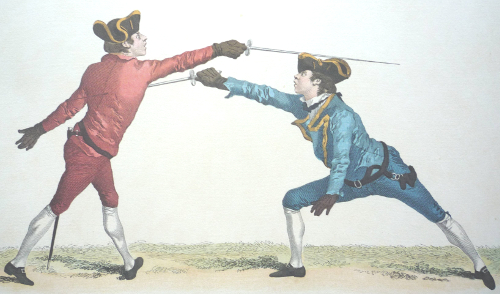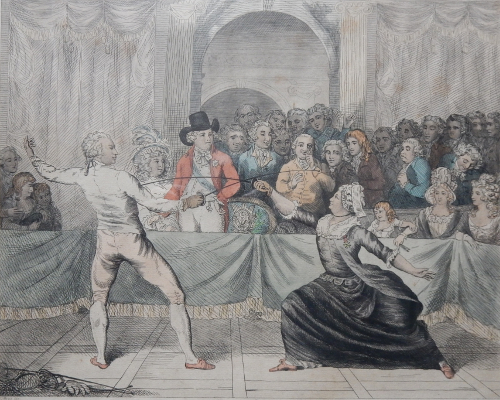We use cookies
Using our site means you agree to the use of cookies and similar technologies. Read about our policy and how to disable them here
“I, with Sir J. Minnes . . . to the New Theatre which ... is this day begun to be employed for the fencers to play prize at. And here I came and saw the first prize I ever saw in my life, and it was between Matthews, who did beat at all weapons, and one Westwicke, who was soundly cut several times in the head and legs that he was all over blood; and other deadly blows did they give and take in very good earnest, till Westwicke was in a most sad pickle. They fought at eight weapons, three bouts at each weapon. I felt one of their swords and found it little, if at all, blunter on the edge than common swords are. Strange to see what a deal of money is flung to them both upon the stage between every bout. But a woeful rude rabble there was and such noises. So, well pleased with the sight. I walked home.”
“Their Royal Highnesses [Gloucester and Cumberland] having signified to me that a Treatise of Fencing, with engravings [L'Ecole des Armes], would contribute much to their amusement, I instantly applied myself to the undertaking. I engaged that gentleman [James Gwynn] to draw all the positions of fencing, for the model of which I myself had the patience to stand and afterwards got executed by the first artists. As the Princes had given occasion to my treatise, I thought it my duty to ask their permission to dedicate it to them, which they granted in the most flattering manner. Some time after this, I was informed by the Duke of Queensbury that his Majesty would be very glad to see the original designs. I ordered them to be arranged with all possible expedition, and every one to be adorned with an elegant border, and the book to be bound in the most superb manner. The king was so good as to examine it, and conversed with me some time on the subject of the book with considerable knowledge. In the year 1771 I had the honour to be appointed fencing master to their Royal Highnesses, the Prince of Wales [later George IV] and Prince Frederick.”[caption id="attachment_1182" align="aligncenter" width="500"]
 A plate from Angelo’s L’Ecole des Armes, 1763[/caption]
The special presentation copy of the original drawings for L'Ecole des Armes, published in 1763, was later acquired by Lord Farnham. In 1961 it was sold at Sotheby's to the American collector, Paul Mellon, and is now in the Yale Center for British Art, New Haven, Connecticut, USA. The Royal Library at Windsor has a proof set of reduced plates commissioned in 1765 for Diderot's encyclopedia. Hand-coloured, mounted and bound in red morocco with a cusped yellow leather border, the plates are prefaced by a manuscript dedication by Angelo to the Prince of Wales.
Angelo also presented specially bound copies of the book to members of the Royal Family; the Prince of Wales had one bound in red pigskin with extensive gold tooling on the borders, his coat of arms embossed in the centre and his feathers badge in each corner (now in the Royal Collection); others bound in olive morocco with the same gold tooling and the Prince of Wales feathers badge in each corner were given to the Dukes of York, Gloucester and Cumberland and two Princes of Mecklenburg, brothers of Queen Charlotte.
A plate from Angelo’s L’Ecole des Armes, 1763[/caption]
The special presentation copy of the original drawings for L'Ecole des Armes, published in 1763, was later acquired by Lord Farnham. In 1961 it was sold at Sotheby's to the American collector, Paul Mellon, and is now in the Yale Center for British Art, New Haven, Connecticut, USA. The Royal Library at Windsor has a proof set of reduced plates commissioned in 1765 for Diderot's encyclopedia. Hand-coloured, mounted and bound in red morocco with a cusped yellow leather border, the plates are prefaced by a manuscript dedication by Angelo to the Prince of Wales.
Angelo also presented specially bound copies of the book to members of the Royal Family; the Prince of Wales had one bound in red pigskin with extensive gold tooling on the borders, his coat of arms embossed in the centre and his feathers badge in each corner (now in the Royal Collection); others bound in olive morocco with the same gold tooling and the Prince of Wales feathers badge in each corner were given to the Dukes of York, Gloucester and Cumberland and two Princes of Mecklenburg, brothers of Queen Charlotte.
 Gillray’s engraving of the match between the Chevalier de Saint-Georges and the Chevalier d’Eon before the Prince of Wales[/caption]
In 1789 another exhibition of fencing, this time between the master Joseph Roland and Saint-Georges, was held before the Prince of Wales at the Royal Pavilion, Brighton. Afterwards the Prince asked for a set of foils, masks and gloves, for which Roland was suitably rewarded. These objects are no longer in the Royal Collection and seem to have vanished without trace.
In the mid-19th century a fresh impetus was given to the sport with the arrival of Prince Albert. In 1838 while at Bonn University, he received a certificate for fencing and his fellow student Prince William of Lowenstein later recalled, “In fencing and the practice of the broadsword he was very skilful. In fencing especially he excelled so much that once in a fencing match he carried off the prize from all his competitors.” This interest was passed on to his children, the Prince of Wales [later Edward VII] and Prince Alfred, Duke of Edinburgh, who were members of the London Fencing Club from 1865 until the end of the century. In the LFC's 1866 ledger of members' vital statistics, the Duke of Edinburgh (who was then aged 22) is recorded as weighing 10½ stone and having a 38 inch chest, 12 1/8 inch upper arm and 10½ inch forearm. His elder brother does not appear to have submitted to measurement.
The princes were taught fencing by Pierre Prevost until his death in 1869 and then by Baptiste Bertrand, the first of three generations of fencing masters, who later taught the three daughters of the Prince of Wales, Louise, Victoria and Maud. Their example was followed by many younger members of the Court circle and made fencing for women fashionable.
Gillray’s engraving of the match between the Chevalier de Saint-Georges and the Chevalier d’Eon before the Prince of Wales[/caption]
In 1789 another exhibition of fencing, this time between the master Joseph Roland and Saint-Georges, was held before the Prince of Wales at the Royal Pavilion, Brighton. Afterwards the Prince asked for a set of foils, masks and gloves, for which Roland was suitably rewarded. These objects are no longer in the Royal Collection and seem to have vanished without trace.
In the mid-19th century a fresh impetus was given to the sport with the arrival of Prince Albert. In 1838 while at Bonn University, he received a certificate for fencing and his fellow student Prince William of Lowenstein later recalled, “In fencing and the practice of the broadsword he was very skilful. In fencing especially he excelled so much that once in a fencing match he carried off the prize from all his competitors.” This interest was passed on to his children, the Prince of Wales [later Edward VII] and Prince Alfred, Duke of Edinburgh, who were members of the London Fencing Club from 1865 until the end of the century. In the LFC's 1866 ledger of members' vital statistics, the Duke of Edinburgh (who was then aged 22) is recorded as weighing 10½ stone and having a 38 inch chest, 12 1/8 inch upper arm and 10½ inch forearm. His elder brother does not appear to have submitted to measurement.
The princes were taught fencing by Pierre Prevost until his death in 1869 and then by Baptiste Bertrand, the first of three generations of fencing masters, who later taught the three daughters of the Prince of Wales, Louise, Victoria and Maud. Their example was followed by many younger members of the Court circle and made fencing for women fashionable.

